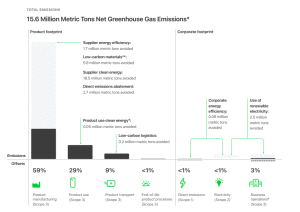Apple defies expectations with a stellar third-quarter performance, raking in $85.5 billion in revenue and $1.40 per share in earnings. While iPhone sales dipped, Apple’s China revenue is on the rebound.
Beyond these financial feats, would Apple succeed in charging ahead with its bold mission to achieve carbon neutrality by 2030? We unveil how far the tech giant is performing so far in this environmental quest.
Apple Surpasses Q3 Forecasts Despite Drop in iPhone Sales
Apple announced its third-quarter earnings, surpassing analysts’ expectations for both revenue and profit, despite a year-over-year decline in iPhone sales. Apple’s China revenue reached $14.7 billion, below the $15.2 billion anticipated by analysts and down from $15.7 billion the previous year.
Despite the miss, Apple CFO Luca Maestri noted that sales in China are generally improving, with record upgrades and better performance than in the first half of the year. Overall, iPhone sales were $39.2 billion, just below the $39.6 billion from Q3 2023 but exceeding expectations of $38.9 billion.
For the quarter, Apple reported earnings per share (EPS) of $1.40 on revenue of $85.5 billion, beating analyst forecasts of $1.35 EPS and $84.4 billion in revenue. The iPhone maker’s shares changed a little in Friday’s pre-market trading, down by less than 1%.
Apple’s Ambitious Carbon Neutral Goal
Apple has set a formidable target: to be carbon neutral across its entire carbon footprint by 2030. This commitment involves reducing scope 1, 2, and 3 emissions — encompassing all direct and indirect emissions from its operations and value chain — by 75% before balancing the remaining emissions with high-quality carbon removals.
Since 2015, Apple has already managed to cut its emissions by more than 55%, despite a 64% increase in revenue over the same period. The focus is on decarbonizing the three largest sources of emissions: materials, electricity, and transportation.
Comprehensive Carbon Footprint
In 2023, Apple’s environmental initiatives helped avoid 31 million metric tons of emissions. These efforts include sourcing 100% renewable energy for its facilities, transitioning suppliers to renewable energy, and using low-carbon materials in products. Despite substantial revenue growth since 2015, Apple’s gross emissions have decreased significantly.
Apple’s commitment to carbon neutrality involves setting science-based targets to reduce emissions by 75% by 2030 and investing in high-quality carbon removal projects for emissions that cannot be mitigated with existing solutions.
Four Pillars of Carbon Emission Reduction
- Design and Materials: Apple aims to design products and manufacturing processes that are less carbon-intensive. This includes thoughtful material selection, increased material efficiency, greater product energy efficiency, the use of recycled and renewable materials, and enhanced material recovery.
- Electricity: Increasing energy efficiency and transitioning the entire product value chain to 100% clean electricity by 2030 is a priority. This includes both the electricity used in manufacturing and by customers during product use.
- Direct Emissions: Apple is working to reduce direct greenhouse gas emissions through process innovation, emissions abatement, and shifting away from fossil fuels.
- Carbon Removal: In parallel with emissions reduction efforts, Apple is scaling up investments in carbon removal projects, including nature-based solutions that protect and restore ecosystems.
Decarbonizing the Value Chain
Electricity:
Electricity for manufacturing and charging devices is the largest source of Apple’s emissions. To achieve carbon neutrality, Apple has launched the Supplier Clean Energy Program, which encourages suppliers to use 100% renewable electricity for all Apple production by 2030. More than 320 global suppliers have joined the program, representing 95% of Apple’s direct manufacturing spend.
Additionally, the tech giant is investing in renewable energy to ensure that the electricity associated with customers’ product use is matched by clean energy.
Materials:
Apple aims to use recycled and renewable materials, which typically have a lower carbon footprint than primary materials. By 2025, the company plans to use 100% recycled cobalt in all Apple-designed batteries, 100% recycled tin soldering, 100% recycled gold plating in circuit boards, and 100% recycled rare earth elements in all magnets across new products.
In 2023, manufacturing accounted for 59% of Apple’s gross carbon footprint. The iPhone maker continues to launch supplier programs targeting emissions from manufacturing operations and facilities.
Transportation:
In 2023, transportation accounted for 9% of Apple’s gross carbon footprint. The company is shifting more product volume to less carbon-intensive shipping modes, such as ocean or rail, which generate significantly fewer emissions than air transport.
Additionally, Apple is also exploring the use of low-carbon sustainable aviation fuels (SAF) to reduce the carbon footprint of shipment.
Investing in Carbon Removals
While prioritizing emissions reductions is critical, Apple also invests in high-quality carbon credits from nature-based projects to address emissions that cannot be reduced. These projects focus on carbon sequestration, such as planting forests and restoring mangroves, and offer additional benefits that improve climate adaptation and resilience. Apple ensures that the credits from these investments are additional, permanent, measurable, and quantified, with systems in place to avoid double-counting and leakage.
- CHECK THIS OUT: Apple, Netflix, Shell, Delta Join Kenya’s Carbon Credit Boom
In March 2024, Apple welcomed new investors to the Restore Fund, including Taiwan Semiconductor Manufacturing Company (TSMC) and Murata, with investments of up to $50 million and $30 million respectively. Managed by Climate Asset Management, this brings the total fund to $280 million, building on Apple’s initial $200 million commitment.
Moving forward, Apple aims to achieve carbon neutrality across its entire carbon footprint by 2030 and is committed to a 90% reduction in emissions from its 2015 baseline by 2050. This ambitious target aligns with the Intergovernmental Panel on Climate Change’s (IPCC) recommendation for global carbon neutrality and requires a collective, worldwide effort.
Apple continues to lead in both financial performance and environmental sustainability, demonstrating strong revenue growth and a firm commitment to achieving carbon neutrality by 2030. Through innovative strategies in energy efficiency, renewable energy, and carbon removal, Apple sets a high standard for corporate responsibility and environmental stewardship.




